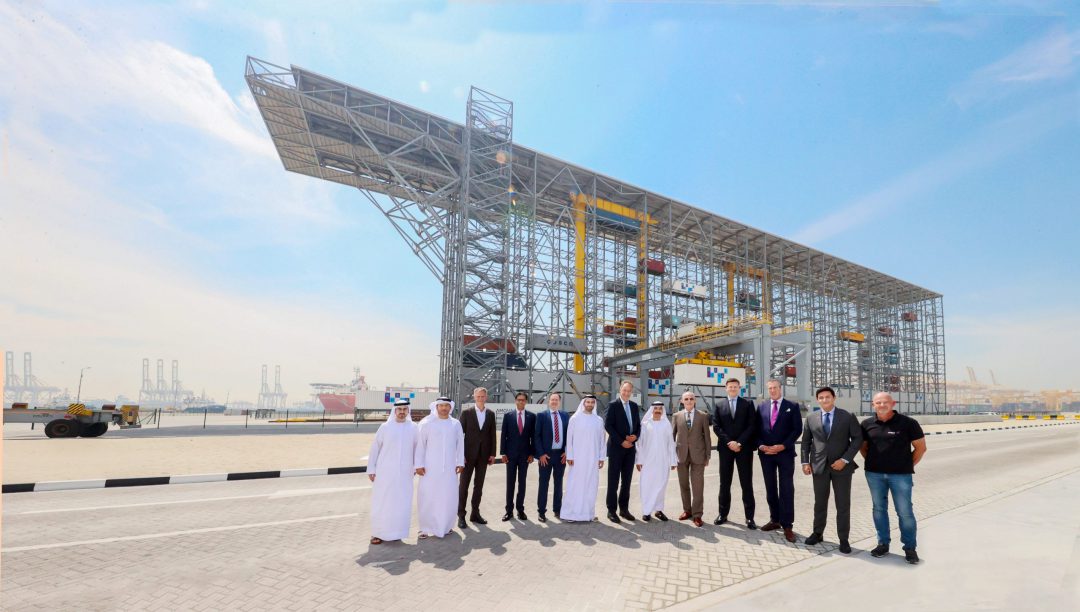DP World has announced the first commercial use of its revolutionary BOXBAY high-bay storage system at their terminal in Pusan, South Korea.
A contract was signed between Pusan Newport Corporation and Boxbay FZCO – a joint venture of DP World and German plant technology supplier, SMS group – initiating the design and engineering works for the site. The signing took place in Jebel Ali Free Zone, Dubai, and was signed by Sultan Ahmed Bin Sulayem, Group Chairman and CEO of DP World and Burkhard Dahmen, Chairman and CEO of SMS group, the partners behind BOXBAY.
PNC already operates one of the highest performing container terminals in Asia. The addition of BOXBAY’s technology will allow PNC to boost its efficiency even further.
The BOXBAY high-bay storage technology will be seamlessly integrated along with the existing mode of ARMG/truck operations as a retrofit on an existing empty storage area. The system allows direct access to each container at any time, eliminating 350,000 unproductive moves per year. This will improve the overall truck servicing time by 20 percent, further improving PNC service delivery to its customers.
BOXBAY is fully automated with additional safety features built in. DP World also intends to power it by using solar power, generated by photovoltaic panels on the roof of the storage system, complementing DP World’s drive to decarbonise operations.
Sultan Ahmed Bin Sulayem, Group Chairman and CEO of DP World, said: “If we were to imagine the future of trade, this is where it begins. We have taken a technology that has proven its effectiveness in the metals industry in Germany and further transformed it to create BOXBAY, an innovative container storage system to enhance global trade. Our pilot scheme in Jebel Ali has already shown the advantages of a fully automated, sustainably powered high-bay storage system. I’m proud that DP World has led this innovation that will now be adopted in Pusan. The technology reflects our continuous efforts to embrace technologies that enhance the flow of trade and further enhances Dubai’s position as a global leader in the ports and logistics industry.”
Tiemen Meester, COO Ports & Terminals, DP World, said: “We have long invested in new and innovative technology that will improve and modernise our ports and terminals. It’s a tremendous step forward to announce our first commercial use of BOXBAY. The PNC terminal is an exemplary operation that is already technologically advanced and forward focused. With the introduction of the BOXBAY high-bay storage system, we will be able to better serve our customers while keeping our people safe and cutting carbon emissions from the environment.”
Glen Hilton, CEO & Managing Director, DP World Asia Pacific & Australasia, said: “We are delighted to see this technology implemented first at one of our terminals. Safety, sustainability and efficiency are huge drivers for our business. We look forward to working with the PNC and BOXBAY teams to implement this system without any interruption to our current services.”
DP World developed BOXBAY in a joint venture with German plant technology supplier SMS group, who originally created the storage system to handle heavy metal coils. Having proven the technology in the metals industry, it was refined for port logistics. DP World and SMS built a pilot facility at Jebel Ali’s Terminal-4 in January 2021. By the end of June 2022, 190,000 container movements had been carried out under realistic operating conditions to verify the market maturity of the system.
DP World has a 66% stake in PNC, which handled 5.3 million TEUs in 2021. PNC operates in Pusan port, which is the tenth largest in the world.

























